How the Moon Formed: 5 Wild Lunar Theories
Introduction
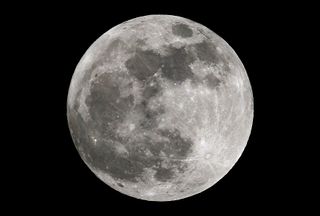
The moon has fascinated humanity for millenia, exerting a powerful pull on our imagination just as it tugs on the oceans to create the tides.
After gazing up at the moon for all those years, however, we're still not exactly sure how it came to be. Here's a brief rundown of the most prominent theories scientists have come up with to explain the moon's origin, including a few relatively wild ones with little observational evidence to back them up. [The Moon: 10 Surprising Lunar Facts]
FIRST STOP: A Captured Moon?
Capture

Some researchers suggest that the moon may have originally formed elsewhere — perhaps even around another planet, such as Venus — before being grabbed by Earth's gravitational pull. Other worlds have gained moons in this manner. For example, Phobos and Deimos, the two tiny satellites of Mars, are thought to be captured asteroids.
The capture idea isn't really an origin theory, of course; it just concerns how the moon came to orbit Earth. And it has some major problems, the most serious of which is the geochemical similarity of the Earth and moon. The two bodies have nearly identical oxygen isotope ratios, suggesting that they formed from the same pool of raw material.
NEXT: Spinning Off
Fission
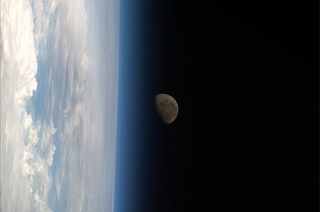
Another idea — apparently thought up by Charles Darwin's son George in the 19th century — posits that the material that formed the moon was ejected into space by a molten, fast-spinning Earth in the very early days of the solar system.
Most scientists discount the fission hypothesis, saying that Earth could not have been spinning fast enough to expel a huge blob of rock. But one 2010 study suggested that a natural nuclear explosion, set up by the superconcentration of radioactive elements, may have provided the kick to dislodge a moon-size piece of the early Earth into orbit.
NEXT: Forming With Earth
Co-formation
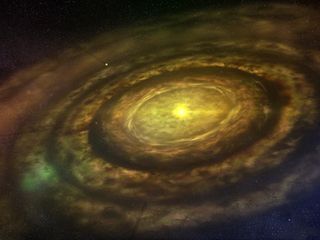
It's also possible that the moon formed alongside Earth 4.5 billion years ago, coalescing from gas and dust in the same part of our solar system's protoplanetary disk.
While this hypothesis can account for the isotopic similarities between the Earth and moon, it falls short in other ways. It cannot explain the high angular momentum of the Earth-moon system, for example, or why the moon has such a small iron core compared to that of our planet.
NEXT: Asteroid Rubble
Colliding planetesimals
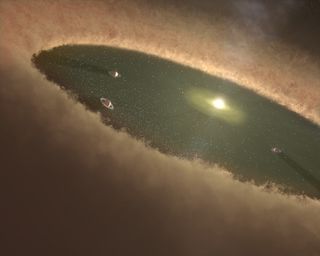
Some scientists have suggested that the moon condensed from the debris produced when planetesimals — the building blocks that grew into Earth, Mars and other full-fledged planets — slammed into each other shortly after the solar system formed.
Little evidence supports this theory, which also cannot explain the geochemical similarities between the Earth and its natural satellite.
NEXT: A Huge Smash-Up
Giant impact
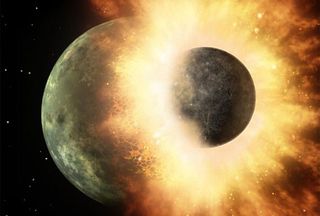
The leading theory of the moon's formation posits that it coalesced from material blasted into space when a planet-size body slammed into the newly formed Earth about 4.4 billion years ago.
One variant of this idea holds that the impactor, dubbed "Theia," was about the size of Mars. Another version, introduced in 2012, suggests that both the impactor and the target — the proto-Earth — were about 50 percent as massive as Earth is today.
While the giant-impact hypothesis continues to be tweaked and refined, it does the best job of explaining the moon's composition and orbit, most scientists say. For example, the theory predicts a small iron core for the moon, since it would have formed primarily from the mantles of the impactor and early Earth (both of which lacked iron, which had already been concentrated deep in the core).
Join our Space Forums to keep talking space on the latest missions, night sky and more! And if you have a news tip, correction or comment, let us know at: community@space.com.
Get the Space.com Newsletter
Breaking space news, the latest updates on rocket launches, skywatching events and more!

Michael Wall is a Senior Space Writer with Space.com and joined the team in 2010. He primarily covers exoplanets, spaceflight and military space, but has been known to dabble in the space art beat. His book about the search for alien life, "Out There," was published on Nov. 13, 2018. Before becoming a science writer, Michael worked as a herpetologist and wildlife biologist. He has a Ph.D. in evolutionary biology from the University of Sydney, Australia, a bachelor's degree from the University of Arizona, and a graduate certificate in science writing from the University of California, Santa Cruz. To find out what his latest project is, you can follow Michael on Twitter.
